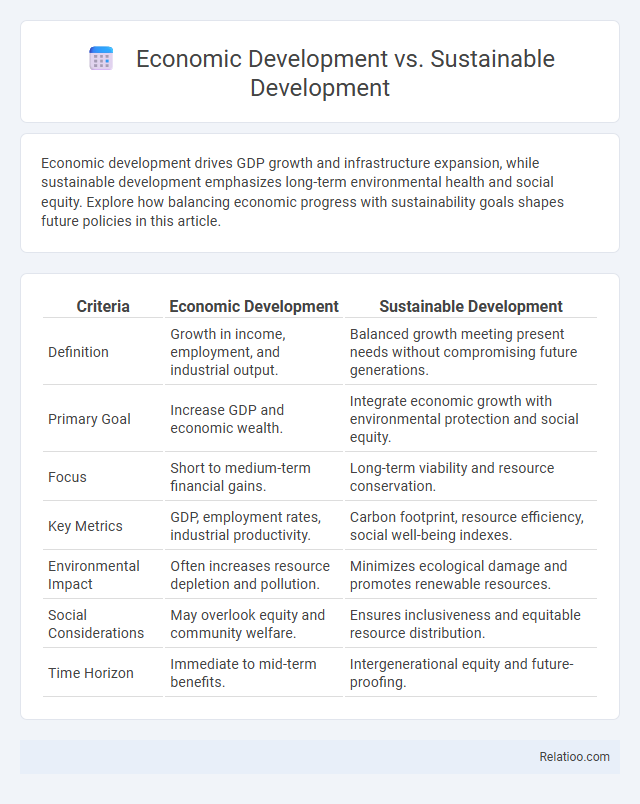Economic development drives GDP growth and infrastructure expansion, while sustainable development emphasizes long-term environmental health and social equity. Explore how balancing economic progress with sustainability goals shapes future policies in this article.
Table of Comparison
| Criteria | Economic Development | Sustainable Development |
|---|---|---|
| Definition | Growth in income, employment, and industrial output. | Balanced growth meeting present needs without compromising future generations. |
| Primary Goal | Increase GDP and economic wealth. | Integrate economic growth with environmental protection and social equity. |
| Focus | Short to medium-term financial gains. | Long-term viability and resource conservation. |
| Key Metrics | GDP, employment rates, industrial productivity. | Carbon footprint, resource efficiency, social well-being indexes. |
| Environmental Impact | Often increases resource depletion and pollution. | Minimizes ecological damage and promotes renewable resources. |
| Social Considerations | May overlook equity and community welfare. | Ensures inclusiveness and equitable resource distribution. |
| Time Horizon | Immediate to mid-term benefits. | Intergenerational equity and future-proofing. |
Understanding Economic Development
Economic development refers to the process of improving economic wealth, productivity, and living standards within a region, primarily through increased industrialization, infrastructure, and income levels. It focuses on measurable indicators such as GDP growth, employment rates, and capital investment, often emphasizing rapid expansion and resource utilization. Distinct from sustainable development, which balances economic progress with environmental protection and social equity, economic development centers more narrowly on financial and structural advancements driving economic prosperity.
Defining Sustainable Development
Sustainable development is defined as meeting the needs of the present without compromising the ability of future generations to meet their own needs, integrating economic growth, social inclusion, and environmental protection. Unlike traditional economic development, which primarily targets financial and industrial expansion, sustainable development recognizes the importance of maintaining ecological balance and promoting long-term well-being. Your understanding of development must embrace these interconnected goals to ensure progress that is equitable and enduring.
Key Differences Between Economic and Sustainable Development
Economic development focuses on increasing a country's wealth and income through industrial growth, infrastructure, and investment, primarily measuring success via GDP and employment rates. Sustainable development aims to balance economic growth with environmental protection and social equity, ensuring that Your progress does not compromise resources or well-being for future generations. The key difference lies in economic development's short-term profit orientation versus sustainable development's long-term integration of ecological health, social inclusion, and economic viability.
Historical Perspectives on Development Models
Historical perspectives on development models reveal distinct approaches: Economic Development emphasizes industrial growth and increased GDP, reflecting post-World War II priorities in the Western world. Sustainable Development emerged later, integrating environmental protection and social equity to address the limitations and negative impacts of purely economic growth models, driven by the 1987 Brundtland Report. Your understanding of development must balance these paradigms to create strategies that promote long-term prosperity without compromising ecological and social well-being.
The Role of Economic Growth in Modern Societies
Economic growth drives increased production, job creation, and higher living standards, forming the backbone of economic development in modern societies. Sustainable development emphasizes balancing economic growth with environmental protection and social equity to ensure long-term prosperity. Your understanding of these concepts helps prioritize policies that foster economic growth while maintaining ecological and social well-being.
Environmental Impacts of Traditional Economic Development
Traditional economic development often prioritizes rapid industrial growth and increased production, leading to significant environmental degradation such as air and water pollution, deforestation, and loss of biodiversity. Sustainable development aims to balance economic progress with environmental protection by integrating renewable resources and eco-friendly practices to minimize ecological footprints. Your choice between these approaches impacts not only economic growth but also the health of ecosystems and the long-term viability of natural resources.
Integrating Sustainability into Economic Policies
Integrating sustainability into economic policies involves balancing economic growth with environmental protection and social equity to achieve long-term development goals. Economic development focuses on increasing GDP and industrial output, while sustainable development prioritizes resource efficiency and intergenerational equity to ensure the well-being of future generations. Effective policy integration requires adopting green technologies, promoting renewable energy, and enforcing regulations that reduce carbon emissions while fostering inclusive economic opportunities.
Case Studies: Successes and Failures
Case studies illustrate that economic development often prioritizes GDP growth, as seen in China's rapid industrialization, which led to impressive economic gains but significant environmental degradation. In contrast, Bhutan exemplifies sustainable development by integrating Gross National Happiness with environmental conservation, balancing economic progress and ecological preservation. Development approaches lacking sustainability, such as rapid urbanization in parts of Africa, highlight failures including resource depletion and social inequality, emphasizing the necessity of incorporating long-term environmental and social goals.
Challenges in Balancing Economic and Sustainable Goals
Balancing economic development and sustainable development presents significant challenges, particularly in addressing resource depletion, environmental degradation, and social equity. Economic growth often prioritizes short-term gains, conflicting with the long-term objectives of sustainability that emphasize ecological preservation and community well-being. Your efforts must navigate these trade-offs to achieve inclusive progress that supports both prosperity and the planet's health.
Future Pathways: Towards Inclusive and Green Growth
Economic development emphasizes increasing a country's wealth through industrialization and market expansion, while sustainable development prioritizes meeting present needs without compromising the environment or future generations. Development, in general, encompasses social, economic, and environmental progress, aiming for a balanced approach. Your role in future pathways involves advancing inclusive and green growth strategies that integrate economic opportunities with environmental stewardship and social equity.

Infographic: Economic Development vs Sustainable Development
 relatioo.com
relatioo.com